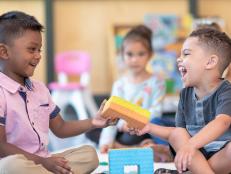A Global Study of Plastic Toys Finds Over 100 Substances That May Be Harmful to Children
Your kids' food isn't the only thing that might contain harmful chemicals.


Elva Etienne
The recent headlines about dangerous levels of chemicals in baby food have many parents cleaning out their kitchens, but a new study suggests you may need to check out some of your kids’ toys as well.
According to a study from Technical University of Denmark (DTU) and the University of Michigan, a team of researchers found more than 100 potentially harmful chemicals in plastic toy materials that may pose possible health risks to children. Researchers from the study say it can be hard for parents to figure out how to avoid the plastic toys that contain these chemicals because of loopholes in regulations.
From fragrances and flame retardants to plasticizers (chemicals that make materials more flexible), researchers said the "Chemicals of Concern" should be banned. However, laws in other countries allow the use of these chemicals. While there are laws in many countries that regulate the use of potentially toxic chemicals in toys, there are no consistent laws globally. So, this means these chemicals can be used to make toys that may end up in your child’s toy box.
"Out of 419 chemicals found in hard, soft and foam plastic materials used in children's toys, we identified 126 substances that can potentially harm children's health," says Peter Fantke, the study's principal investigator. He added, "Being harmful in our study means that for these chemicals, estimated exposure doses exceed regulatory Reference Doses (RfD) or cancer risks exceed regulatory risk thresholds. These substances should be prioritized for phase-out in toy materials and replaced with safer and more sustainable alternatives."
Researchers also noted that toy manufacturers usually don’t provide any information on the chemicals used to make toys. For the study, researchers created a list of the harmful chemicals, measured how much was used in each toy and assessed the risks associated with these toys. This information has been given to lawmakers to help develop stronger global regulations.
So, what can parents do to keep their kids safe when it comes to toys? According to researchers, it’s best to find children’s toys that do not contain plastic, especially if the toys are made in other countries. Wood toys are great options. When your kids are playing with toys, avoid ones that use soft plastics, like baby dolls and action figures. Again, looking for toys made in America can help you eliminate your kids’ exposure to these chemicals. Finally, it can be helpful to ventilate your children's rooms every day.















